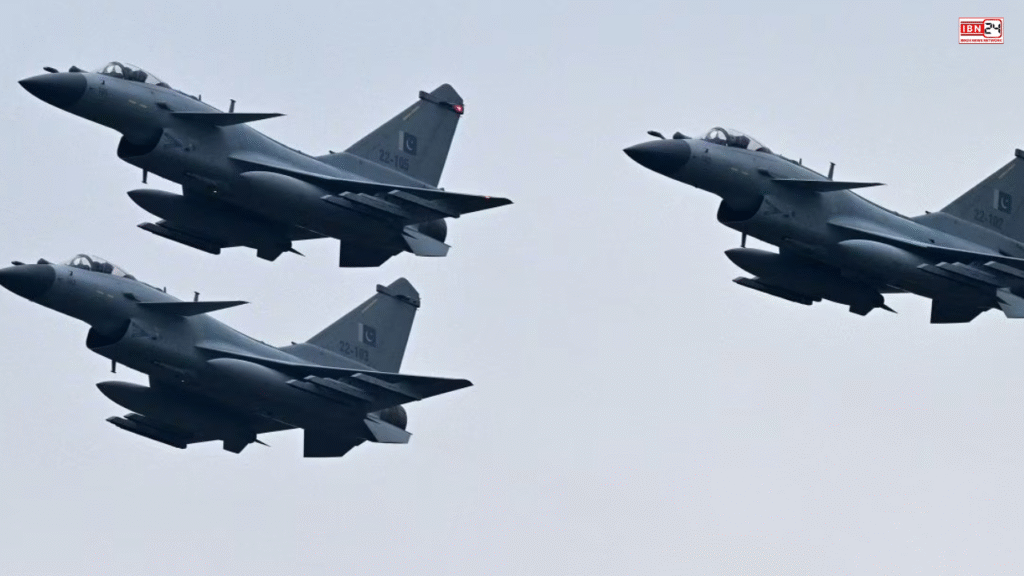9 Aircraft, Drones & Cruise Missiles Destroyed: Air Force
In a major revelation following the Indian Air Force’s recent military action, a report has claimed that six Pakistan Air Force (PAF) fighter jets, two high-value surveillance aircraft, over 10 Unmanned Combat Aerial Vehicles (UCAVs), and a C-130 transport aircraft were destroyed by Indian forces during a four-day conflict with Pakistan. Additionally, multiple Pakistani cruise missiles were intercepted and neutralized.
The information came shortly after a confidential Pakistani dossier reportedly detailed the devastating impact of India’s Operation Sindoor, which also targeted eight additional Pakistani military locations.
Subscribe to IBN24 NEWS NETWORK’s Facebook channel today for real-time updates!
Channel Link: https://www.facebook.com/ibn24newsnetwork
Operation Sindoor: What We Know So Far
According to reports cited by news agency ANI, the revelations were shared by sources directly involved in planning and executing the IAF’s aerial offensive. The sources suggest that the Indian operation has dealt a significant blow to Pakistan’s air defence capabilities, with deep incursions and precision strikes carried out exclusively using air-launched weapons.
During the four-day conflict, India did not use BrahMos surface-to-surface missiles, but relied heavily on air-launched cruise missiles, allowing its fighter jets to hit targets deep inside Pakistani territory with minimal exposure.
High-Value Pakistani Air Assets Destroyed

Among the notable losses for Pakistan were:
- Six PAF fighter jets shot down in aerial engagements.
- Two high-value aerial assets destroyed, reportedly including either electronic warfare aircraft or Airborne Early Warning and Control (AEWC) systems.
- One C-130 Hercules transport aircraft, a crucial logistics support vehicle.
- More than 10 UCAVs, including Chinese-origin Wing Loong drones, taken down by Indian air defence.
Sources indicate that one AEWC aircraft of Swedish origin was destroyed at Pakistan’s through precision air-to-surface cruise missile strikes. Another surveillance platform was reportedly neutralized by a long-range strike from India’s Sudarshan weapon system, launched from approximately 300 km away.
Heavy Damage at Pakistani Air Bases
The IAF operation also reportedly targeted key airbases, including Bholari, using its Rafale and Su-30MKI fighter jets. A hangar at the airbase, believed to be housing additional Pakistani jets, was severely damaged. However, Indian analysts have chosen not to count grounded aircraft losses, as Pakistan has not cleared debris or disclosed full damage reports.
Despite the lack of visual evidence from the ground, Indian technical assessments and satellite imagery indicate significant infrastructural damage.
Drone and Missile Interceptions
India’s air defence network reportedly intercepted a wide range of incoming threats during the conflict:
- Over 10 Pakistani UCAVs were destroyed during aerial incursions.
- Multiple cruise and ballistic missiles launched by Pakistan towards Indian air bases were intercepted mid-air, preventing potential damage and casualties.
The successful neutralization of these airborne threats highlights India’s growing competence in multi-layered air defence and real-time surveillance coordination.
China’s Indirect Involvement?
Interestingly, some of the destroyed drones were reportedly part of the Chinese Wing Loong series, raising questions about the extent of China’s military support or technology transfer to Pakistan. These medium-altitude long-endurance (MALE) drones have previously been used by various militaries for combat and reconnaissance missions.
While there is no official word on Chinese involvement, Indian analysts are likely to review the implications of Pakistan operating such advanced UCAVs in a regional context.
Why Operation Sindoor Matters
The successful execution of Operation Sindoor underscores the Indian Air Force’s preparedness for long-range precision attacks, supported by indigenous and foreign-acquired advanced weaponry. The operation also reflects India’s evolving military doctrine, focusing on preemptive strikes, strategic deterrence, and asymmetric warfare tactics.
As the region continues to witness geopolitical tension, such high-impact air operations have the potential to reshape military strategies on both sides. The IAF’s heavy reliance on air-launched cruise missiles instead of ground-based attacks allowed it to maintain plausible deniability and limit civilian exposure, according to defence experts.
Official Statements Still Awaited
So far, neither the Indian Ministry of Defence nor the Pakistan Armed Forces has issued official statements confirming the full extent of the losses. However, intelligence reports and independent satellite assessments suggest significant military setbacks for Pakistan.
With the analysis of Operation Sindoor still underway, more revelations could emerge in the coming days. For now, the operation is being seen as one of the most strategically impactful air offensives conducted by the IAF in recent years.
For instant news updates, subscribe to the IBN24 NEWS NETWORK YouTube channel
Channel link: https://youtube.com/@IBN24NewsNetwork?si=ofbILODmUt20-zC3
Read Also This article : Vivo T4 Ultra Teased Ahead of India Launch: Periscope Zoom, Dimensity Chip and More Expected